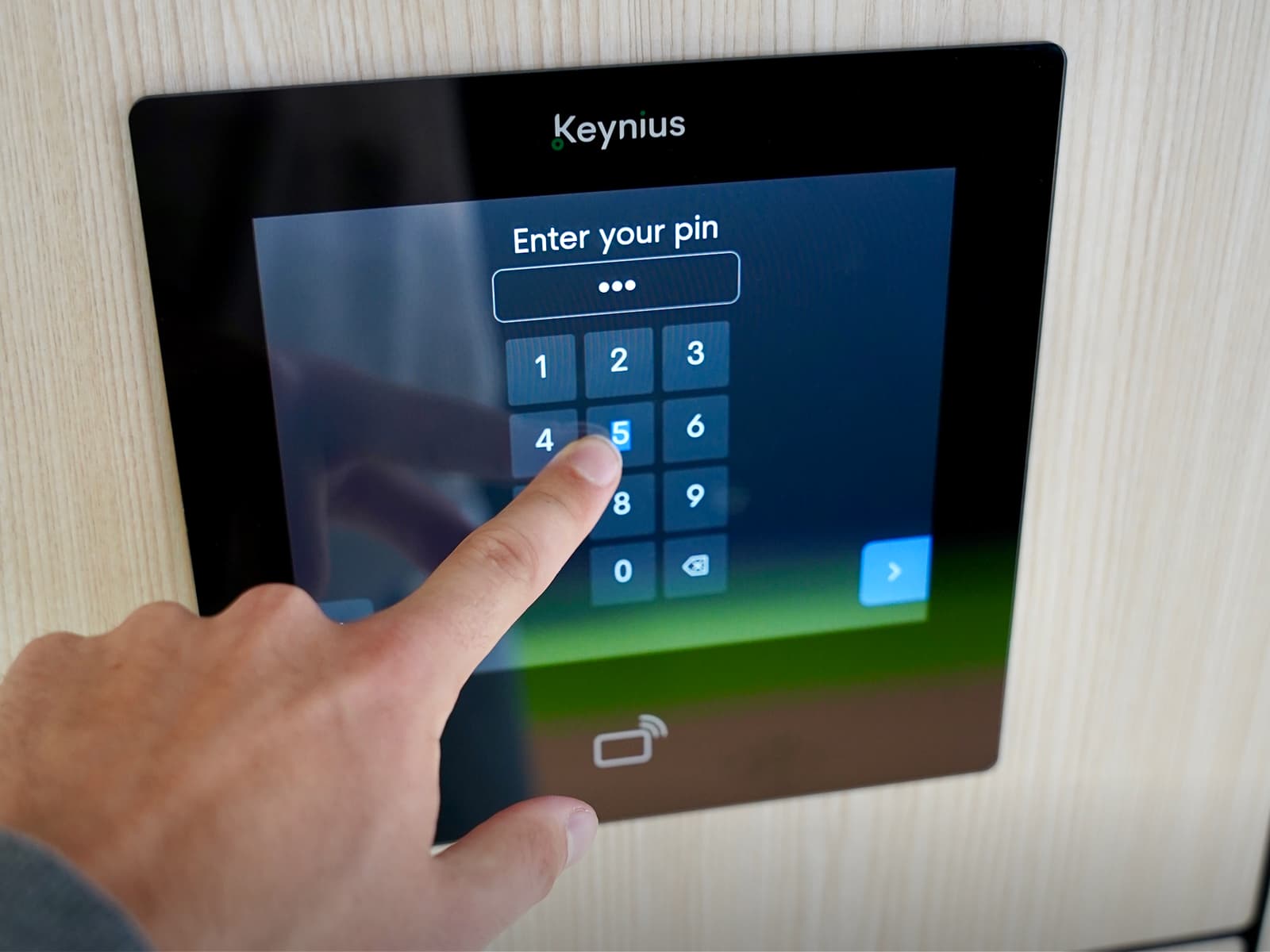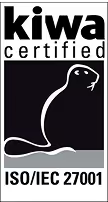The Evolution of Smart Access
Locker systems have moved far beyond keys and coins.
Modern organizations expect digital speed, accountability, and integration with their existing IT systems.
Keynius smart access solutions replace mechanical locks with a flexible digital platform that supports twelve authentication methods.
Each method offers a different way to identify users—so any workplace, venue, or public environment can combine convenience with security and traceability.
1. Fingerprint Access
What it is:
Biometric authentication that verifies a person through their unique fingerprint.
How it works:
A user places their finger on a scanner. The system matches the print with an authorized profile and unlocks the assigned locker instantly.
Why it’s valuable:
No cards or codes to lose. Every access event is tied to a single individual, creating a full audit trail.
Best for:
Hospitals, laboratories, first-response services, industrial sites, or offices requiring personal accountability.
2. Email Authentication
What it is:
Temporary or time-limited access through a link sent to the user’s email.
How it works:
A one-click link opens the assigned locker once and logs the event. No registration or app is needed.
Why it’s valuable:
Ideal for visitors, delivery partners, or temporary staff who only need short-term access.
Best for:
Retail click-and-collect, hospitality guest lockers, education events, and parcel pickup points.
3. Web Browser Login
What it is:
Locker control through a secure web page rather than a dedicated app.
How it works:
Users log in on any browser using their existing organization credentials or single sign-on. From there they can open, reserve, or release lockers remotely.
Why it’s valuable:
Accessible from anywhere, supports remote management, and integrates directly with corporate identity systems.
Best for:
Corporate offices, logistics centers, universities, and shared workspaces.
4. QR Code Access
What it is:
Contactless entry using a scannable QR code displayed on a phone or printed ticket.
How it works:
Each QR code is unique. When scanned at the locker interface, it triggers an unlock command and records the transaction.
Why it’s valuable:
Fast, reliable, and doesn’t require network access—great for self-service environments.
Best for:
Retail pickup, sports venues, transport hubs, and short-term visitor storage.
5. RFID Card Access
What it is:
Access using proximity cards, fobs, or staff badges that contain a small RFID chip.
How it works:
A user holds the card near the reader; the system checks the encrypted chip ID and unlocks the assigned compartment.
Why it’s valuable:
Leverages badges already used for building entry or time tracking—no extra credentials needed.
Best for:
Corporate offices, hospitals, factories, and schools with existing badge systems.
6. Single Sign-On (SSO)
What it is:
Authentication through the organization’s central identity provider such as Microsoft Azure AD or Google Workspace.
How it works:
Employees use the same username and password they use for other corporate tools. Permissions automatically match their role.
Why it’s valuable:
Simplifies administration and ensures only verified employees can access controlled areas.
Best for:
Large enterprises, government offices, universities, and healthcare networks.
7. PIN Code
What it is:
Access through a numeric code entered on a keypad.
How it works:
Each user receives a personal or one-time code. When entered correctly, the system unlocks the locker and logs the time and user.
Why it’s valuable:
Simple, familiar, and doesn’t rely on network coverage—useful as a fallback or in public areas.
Best for:
Gyms, schools, transport hubs, and paid locker rentals.
8. Mobile App
What it is:
Locker access and management through a secure smartphone application.
How it works:
Users authenticate with their credentials or phone biometrics (Face ID or fingerprint). The app connects to the cloud to open or reserve lockers, receive status updates, or extend booking time.
Why it’s valuable:
Provides complete control from anywhere and supports integration with loyalty, booking, or payment systems.
Best for:
Hospitality, retail, recreation facilities, and mobility or transit providers.
9. SMS Access
What it is:
One-time codes delivered by text message for quick entry.
How it works:
The user receives a temporary code valid for a set period. Entering it opens the locker and records the event.
Why it’s valuable:
No smartphone app, Wi-Fi, or registration required—ideal for spontaneous access or public use.
Best for:
Events, healthcare deliveries, guest lockers, or maintenance staff access.
10. Google Wallet
What it is:
Tap-to-unlock using NFC credentials stored in an Android device.
How it works:
The user taps their phone or smartwatch at the reader. The encrypted credential is verified instantly and the locker unlocks.
Why it’s valuable:
Combines security-grade encryption with effortless, contactless use.
Best for:
Transport stations, amusement parks, hotels, and high-traffic retail environments.
11. Apple Wallet
What it is:
Contactless authentication through iPhone or Apple Watch.
How it works:
The user holds their device near the reader. Payment-grade security protocols verify identity in seconds—no PINs or cards required.
Why it’s valuable:
Fast, frictionless, and familiar to users who already use Apple Pay.
Best for:
Events, entertainment venues, and premium guest experiences.
12. Barcode Access
What it is:
Locker access using printed or digital barcodes, similar to ticket or parcel labels.
How it works:
A barcode scanner reads the code, verifies it in the system, and releases the locker. Each scan is logged automatically.
Why it’s valuable:
Works even with basic devices and printed passes; perfect for unattended collection or delivery points.
Best for:
Logistics depots, retail pickups, rental returns, and parcel handovers.
Why Multiple Authentication Options Matter
Each environment requires its own balance of convenience and control.
Hospitals prioritize traceability, stadiums need seamless flow, and corporations demand integration with HR and IT systems.
Keynius allows every authentication method to operate within one connected platform.
Administrators can combine methods, set access durations, define user roles, and review detailed event logs—all from a single dashboard.
This flexibility protects your investment and keeps your access systems aligned with evolving business and compliance needs.
Total Systems Thinking
For Keynius, smart access is part of a larger philosophy: Total Systems Thinking.
Hardware, software, and data are designed to move together—simplifying management, improving security, and giving people the freedom to move intelligently.
Whether biometric, digital, or contactless, every Keynius solution is built for control, intelligence, and harmony.
Discover your ideal authentication mix.
Visit www.keynius.eu to explore how Keynius can simplify and secure access across your organization.
FAQ about Smart Lockers
How does the Keynius locker system work?
Keynius lockers combine smart electronic locks - smart locks and battery locks - with cloud-based software and optional local controllers via our Smart Home Teacher and Students.
Locks connect via LAN or Bluetooth to the Keynius platform, allowing users to authenticate, open, and manage lockers through touchscreens, RFID, PIN, or mobile app.
Admins control access rights, monitor usage, and configure lockers remotely via the Keynius Portal.
Can I customize the locker design and materials?
Yes. We are the only smart locking provider that owns every part of our supply chain, which includes all components, hardware, cabinetry, and software. This allows us to offer the most customizable smart lockers in the industry.
Lockers are available in multiple materials and colors:
Steel, powder-coated in standard RAL colors.
Wood-based panels with extensive Egger color finishes.
HPL laminate for high-durability indoor/outdoor use.
Outdoor waterproof steel version.
Each locker supports optional side panels, bases, benches, and color branding, or vinyl wrapping, as well as your selection of lock type, connection type, and many other custom add-ons.
Is the platform cloud-based or do I need local servers?
The Keynius platform is fully cloud-managed, requiring no local servers. Hardware like Smart Home Teacher/Student units and Battery Locks connect to the cloud via LAN or Bluetooth and are configured through the Keynius Portal or App.
What authentication/access methods are supported?
Supported authentication methods include:
PIN (capacitive keypad or mobile-assigned)
RFID (MiFare, HID, NFC, Apple Wallet)
Mobile app (BLE) for remote and Bluetooth access
QR code scanning (QR Reader IP65)
Payment terminals can optionally authenticate via debit/credit contactless systems.
How secure is the system and where is the data hosted?
Hardware is certified to CE, FCC, UKCA, and RoHS standards, with IP-rated protection up to IP65 for outdoor units.
Locks feature encryption, motorized mechanisms, and mechanical overrides for fail-safe access.
All data, including access logs and credentials, is stored securely in Keynius’ EU-hosted cloud environment compliant with European data protection standards.
Can Keynius integrate with our existing software?
Yes. The system offers open APIs for integration with HR, facility, payment, or booking systems. Payment terminals support remote configuration through the Terminal API.
View our existing integrations here.
What industries or use cases is Keynius suitable for?
Keynius offers a modular, flexible design which makes it compatible for nearly every industry and use-case.
Our most common sectors include:
- Corporate offices (personal storage, hybrid desks)
- Education (student lockers, IT device storage)
- Logistics and retail (parcel and click and collect)
- Leisure, hospitality, and healthcare (staff or visitor lockers)
What’s included in the setup and onboarding process?
Every project is different and requires its own scope, but we strive to offer a consistent and repeatable solution as much as possible to streamline our effectiveness and the quality of service we're able to deliver.
1. Design phase: Configure cabinet models, lock types, and finishes.
2. Installation: Connect Smart Locks to the Smart Home or cloud (plug-and-play).
3. Software setup: Locker walls created in the Keynius Portal; access rights assigned.
4. Training: Admins and users onboarded via the app guide.
5. Support: Remote monitoring, software updates, and Keynius support line.

%20(1).jpg)






%201.svg)
%201.svg)
